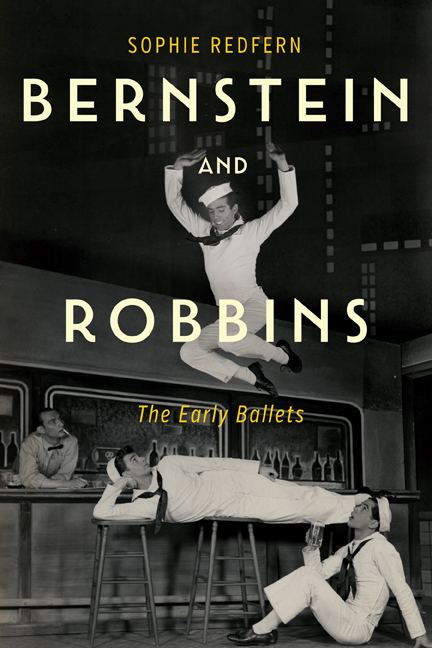Book contents
- Frontmatter
- Dedication
- Contents
- List of Illustrations
- Acknowledgments
- List of Abbreviations
- Editorial Note
- Preface
- 1 Setting the Scene: American Ballet and Jerome Robbins
- 2 Toward a First Ballet: Fancy Free Takes Shape
- 3 Creating Fancy Free: A Long-Distance Collaboration
- 4 The Music of Fancy Free: The Sketches and Score Explored
- 5 The Fancy Free Premiere and a Move to Broadway
- 6 Toward a Second Ballet: Bye Bye Jackie and the Creation of Facsimile
- 7 The Music of Facsimile: The Sketches and Score Explored
- 8 The Facsimile Premiere and Legacy of the Ballets
- Epilogue: Bernstein and Dance
- Bibliography
- Index
3 - Creating Fancy Free: A Long-Distance Collaboration
Published online by Cambridge University Press: 23 March 2021
- Frontmatter
- Dedication
- Contents
- List of Illustrations
- Acknowledgments
- List of Abbreviations
- Editorial Note
- Preface
- 1 Setting the Scene: American Ballet and Jerome Robbins
- 2 Toward a First Ballet: Fancy Free Takes Shape
- 3 Creating Fancy Free: A Long-Distance Collaboration
- 4 The Music of Fancy Free: The Sketches and Score Explored
- 5 The Fancy Free Premiere and a Move to Broadway
- 6 Toward a Second Ballet: Bye Bye Jackie and the Creation of Facsimile
- 7 The Music of Facsimile: The Sketches and Score Explored
- 8 The Facsimile Premiere and Legacy of the Ballets
- Epilogue: Bernstein and Dance
- Bibliography
- Index
Summary
“We first talked it over and then were off,” was how Oliver Smith remembered collaborating with Jerome Robbins and Leonard Bernstein on Fancy Free. He went on:
Oh, I guess Lenny did send Jerry a record or two, and I wrote them both a couple of letters about the sets, but that long distance collaboration is the bunk. When we finally got together again each of us had completed his job and all that remained was to draw the loose ends together.
This statement was made in 1945, a year after the ballet's premiere and in the wake of the work's extraordinary success. It suggests an easy collaboration in which each artist, after an initial conversation, worked independently and minor details were discussed at the end. However, the archives reveal a far more convoluted process. Robbins, who led all aspects of the project and ultimately had the final say on what Bernstein and Smith produced, was kept continually informed on progress and questioned and requested revisions from his collaborators at every stage. As such, far more than a just couple of letters and the odd record were exchanged. Robbins's own letters appear to have been lost, with just a handful of notes and letters to others detailing the process from his side, but through the letters written to him by Bernstein, Smith, and Ballet Theatre a picture of the genesis of Fancy Free emerges.
Close collaboration on the ballet was always going to be a challenge since the artists were rarely together in New York during its creation. Soon after the initial meetings they were plunged into a long-distance relationship: Robbins embarked on a nationwide tour with Ballet Theatre and Bernstein was reaping the rewards of his dramatic New York Philharmonic conducting debut by taking engagements with orchestras across the country. Only Smith remained in the city, so letters and telegrams were the primary form of communication. Smith wrote at length to Robbins, not only about the scenic design but also about his dealings with Ballet Theatre management. Bernstein, for his part, was in almost constant contact with the choreographer as he composed the score. Each musical scene was sent to Robbins for approval with an accompanying letter in which Bernstein explained what he had done and why.
- Type
- Chapter
- Information
- Bernstein and RobbinsThe Early Ballets, pp. 65 - 96Publisher: Boydell & BrewerPrint publication year: 2021



